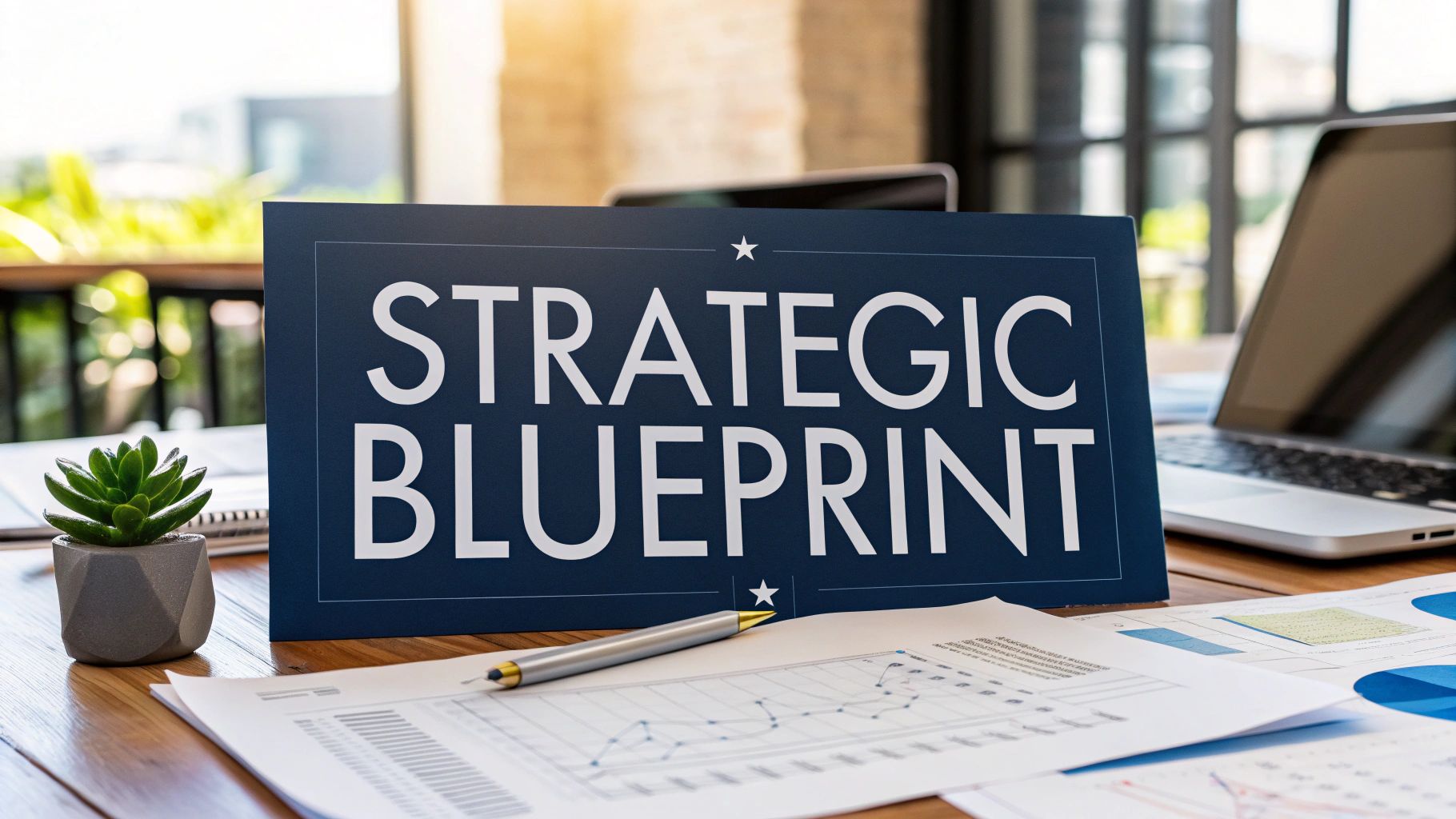Understanding the Business Model Canvas Framework
The Business Model Canvas helps businesses plan and map out their strategy in a simple, visual way. Instead of creating lengthy business plans, companies can use this tool to break down their operations into clear, connected parts. This makes it easier for teams to work together, spot opportunities, and adapt their strategy as needed.
The Nine Building Blocks of the Canvas
At its core, the Business Model Canvas has nine key elements that work together to show how a business creates and captures value. Here are the essential building blocks:
- Customer Segments: Who are your target customers and what do they need?
- Value Propositions: What unique benefits do you offer that solve customer problems?
- Channels: How do you deliver your product or service to customers?
- Customer Relationships: How do you interact with and retain customers?
- Revenue Streams: What are your main sources of income?
- Key Activities: Which core tasks must you perform to deliver value?
- Key Resources: What assets (people, technology, facilities) do you need?
- Key Partnerships: Which suppliers and partners help support your business?
- Cost Structure: What are your major expenses and financial priorities?
This organized approach helps teams focus on what matters most and see how different parts of the business connect. It also makes it easier to test new ideas and adjust plans based on results.
Alexander Osterwalder, a Swiss entrepreneur and co-founder of Strategyzer, developed the Business Model Canvas during his PhD research. The framework helps businesses understand and improve how they create, deliver and capture value. You can learn more about its origins here: Business Model Canvas History and Template.
Using the Business Model Canvas Template Effectively
The Business Model Canvas works well for all types of organizations - from new startups to large companies and nonprofits. Teams can use it to map out their current business model, spot problems, and explore new opportunities. The visual format makes complex ideas easier to discuss and refine.
Regular review and updates of your canvas help keep your strategy fresh and responsive to market changes. This ongoing process helps teams make better decisions about where to focus resources and how to grow the business. For example, you might use the canvas to test new product ideas or find ways to reduce costs. You might be interested in: Our sitemap for further reading.
Implementing the BMC for Digital Transformation

The Business Model Canvas (BMC) serves as a practical tool for businesses adapting to change. It offers a clear structure to help companies spot new opportunities and tackle the challenges that come with implementing new systems and processes.
Mapping Digital Initiatives with the BMC
The BMC template helps businesses visualize how digital projects affect different parts of their operations. When you map out initiatives like moving sales online, you can see exactly how they impact your customer connections, costs, and revenue sources. This clear picture helps teams make better decisions about where to focus resources.
Measuring the Impact of Digital Transformation
Using the BMC makes it easier to track how well your digital changes are working. By checking the canvas after launching new initiatives, you can easily spot what's working and what needs adjustment. This step-by-step approach helps ensure you get real value from your investments in new technology.
Aligning Digital Strategies with Business Objectives
The BMC helps keep everyone focused on the same goals by showing the whole business picture in one place. When teams share this common view, they naturally work better together instead of getting stuck in separate silos. This shared understanding helps ensure digital projects support the company's main objectives.
A real example shows how well the BMC works. Research at Zarqa University surveyed 269 academics about using the BMC. 88.9% agreed it was especially helpful for understanding customer segments and communication channels. The study highlighted how the BMC helps organizations see their capabilities clearly and understand how IT systems fit into the bigger picture. Want to dig deeper? Check out the complete research findings. This case shows how the BMC gives organizations a practical way to manage change and growth.
Creating Impact Through Social Enterprise Canvas Models

Running a social enterprise means doing two things at once - making money and making a difference. This requires a special approach to business planning that keeps both goals in focus. By modifying the standard Business Model Canvas, social entrepreneurs can build organizations that succeed on both fronts.
Measuring Social Impact with the Business Model Canvas Template
While regular business models focus mostly on profits, social enterprises need to track how much good they're doing too. The key is adding impact measurement sections to your canvas. For instance, if you're providing clean water access, you'd want to count exactly how many people now have safe drinking water. These concrete numbers show your real impact.
Balancing Purpose and Profit
Success comes when your social mission and business model work together naturally. A well-designed canvas helps you spell out your value proposition - what you offer both paying customers and the people you help. The money you make should directly fund more impact. Getting this connection right helps you grow sustainably.
Engaging Stakeholders Effectively
Social enterprises work with more groups than regular businesses do - from investors and customers to community members and government partners. Your canvas should map out how you'll connect with each one clearly. Good communication builds trust and keeps everyone focused on shared goals. The canvas gives you a framework for managing these complex relationships well.
The Impact Business Model Canvas adds special sections just for social enterprises. These help you define who you want to help, what change you want to create, and how you'll measure success. Both nonprofits and socially-minded companies use this tool to plan better. Learn more about the Impact BMC and examples of its use. This approach helps entrepreneurs build organizations that do good while doing well.
Overcoming SME Implementation Challenges
Small and Medium Enterprises (SMEs) face unique difficulties when rolling out the Business Model Canvas. While limited staff and budget can make big-picture planning feel overwhelming, there are practical ways to make this tool work effectively for smaller companies.
Making the Canvas Work for SMEs
Many business owners wrongly believe they need extensive resources to use the canvas effectively. In reality, successful SMEs customize the tool based on their current needs. For example, a new local bakery might concentrate first on understanding their customer segments, crafting their value proposition, and selecting their channels. Meanwhile, established businesses may dive deeper into analyzing costs and building partnerships. This focused approach helps smaller companies get real value without becoming overwhelmed.
Getting Market Insights on a Budget
You don't need expensive consultants to understand your market. Smart SMEs use simple tools like social media surveys, direct customer conversations, and free online resources to learn about their audience. Regular team discussions about the canvas help everyone stay aligned and contribute ideas. When staff at all levels participate, the business model becomes clearer and more actionable.
Making Real Changes Step by Step
The key is starting small with clear goals tied to your canvas analysis. If you discover you need stronger customer relationships, begin with a basic email newsletter to stay in touch with clients. Taking this gradual approach prevents team burnout while allowing for steady improvements. Remember to review your canvas regularly so it stays current with market changes.
Recent research among Saudi Arabian e-commerce SMEs revealed interesting patterns. While most companies understood basics like customer segments, many struggled with key activities and revenue planning. This shows SMEs need clear, practical guidance for implementation. Learn more about these findings in this detailed study of SME canvas implementation.
Real Success Stories
Small businesses across industries have used the canvas to grow. A local clothing store analyzed their canvas and identified online shoppers as a new customer segment, leading them to launch e-commerce sales. Similarly, a small consulting company refined their value proposition through the canvas process and attracted higher-value clients. These examples show how SMEs can use this tool to think clearly about their business and adapt successfully to change.
Customizing Your Canvas for Maximum Impact

While the standard business model canvas gives you a solid starting point, its real value comes from making it your own. By adapting the canvas to match your specific business needs, you can gain deeper insights and make smarter decisions that directly impact your success.
Industry-Specific Performance Metrics
Different businesses need different ways to measure success. For example, software companies track customer churn and recurring revenue, while retail stores focus on sales per square foot and how quickly products move off shelves. Adding these specific metrics to your canvas helps you measure what matters most for your industry. This makes it easier to spot trends and find ways to improve.
Dealing With Your Market's Unique Challenges
Each business faces its own obstacles. Your canvas should address these head-on. If you work in a heavily regulated field, you might want to add a section about compliance requirements. Or if you're trying to shake up an existing market, consider adding a section to track your competitors' moves. This helps you stay ahead of problems and grab new opportunities.
Making Sure Everyone Gets It
Even when customized, your canvas needs to clearly show how your business works to your team, investors, and partners. A good visual layout helps everyone understand how different parts of the business connect. Simple tricks like using different colors for customer groups or key activities can make your canvas easier to grasp at a glance.
Real-World Canvas Examples
Different companies adapt their canvases in creative ways. Some expand the Value Proposition part to really dig into what customers need. Others adjust the Channels section to map out both digital and physical ways they reach customers. These changes show how flexible the canvas can be while still keeping its core strengths.
A Simple Way to Customize Your Canvas
Start by looking at the nine basic sections in your canvas. Think about which parts need more detail for your specific business. Feel free to add new sections or change existing ones to better match your needs. Just remember to keep things clear and focused on what's most important. This turns your canvas into a practical tool that helps you plan, communicate, and grow your business.
Building Future-Ready Business Models

Your business model canvas needs to be a dynamic tool that adapts alongside market changes. Instead of a static document, make it an active framework that helps your company stay competitive and resilient.
Spotting and Acting on New Opportunities
Smart companies don't just respond to changes - they look ahead to spot them early. Keep an eye on shifts that could affect your customer segments, ways to deliver value, and new channels to reach people. For instance, if you run a retail store, you might add online ordering or start a subscription service based on changing shopping habits.
Making Regular Updates
Don't let your canvas get stale. Set up monthly or quarterly reviews with team members from different departments. Having varied viewpoints helps ensure your business model stays practical and meets real customer needs. Think of these reviews as tune-ups that keep your business running smoothly.
Planning for Different Futures
While you can't predict everything, you can prepare for various possibilities. Use scenario planning to map out different "what if" situations - like new competitors entering the market or major tech changes. This helps you spot both risks and opportunities early, letting you adjust your approach based on what actually happens.
Keeping Operations Strong During Change
As you adapt, don't forget about running your current business well. Keep your essential key activities efficient and maintain a clear view of your cost structure. Regular canvas updates help balance trying new things with keeping daily operations smooth. This way, you can build for tomorrow while succeeding today.
Ready to take control of your business future? The Covered Call podcast shares real stories and practical advice from entrepreneurs who've built successful, adaptable companies. Learn how they spotted opportunities and stayed resilient through change. Listen to The Covered Call Podcast

